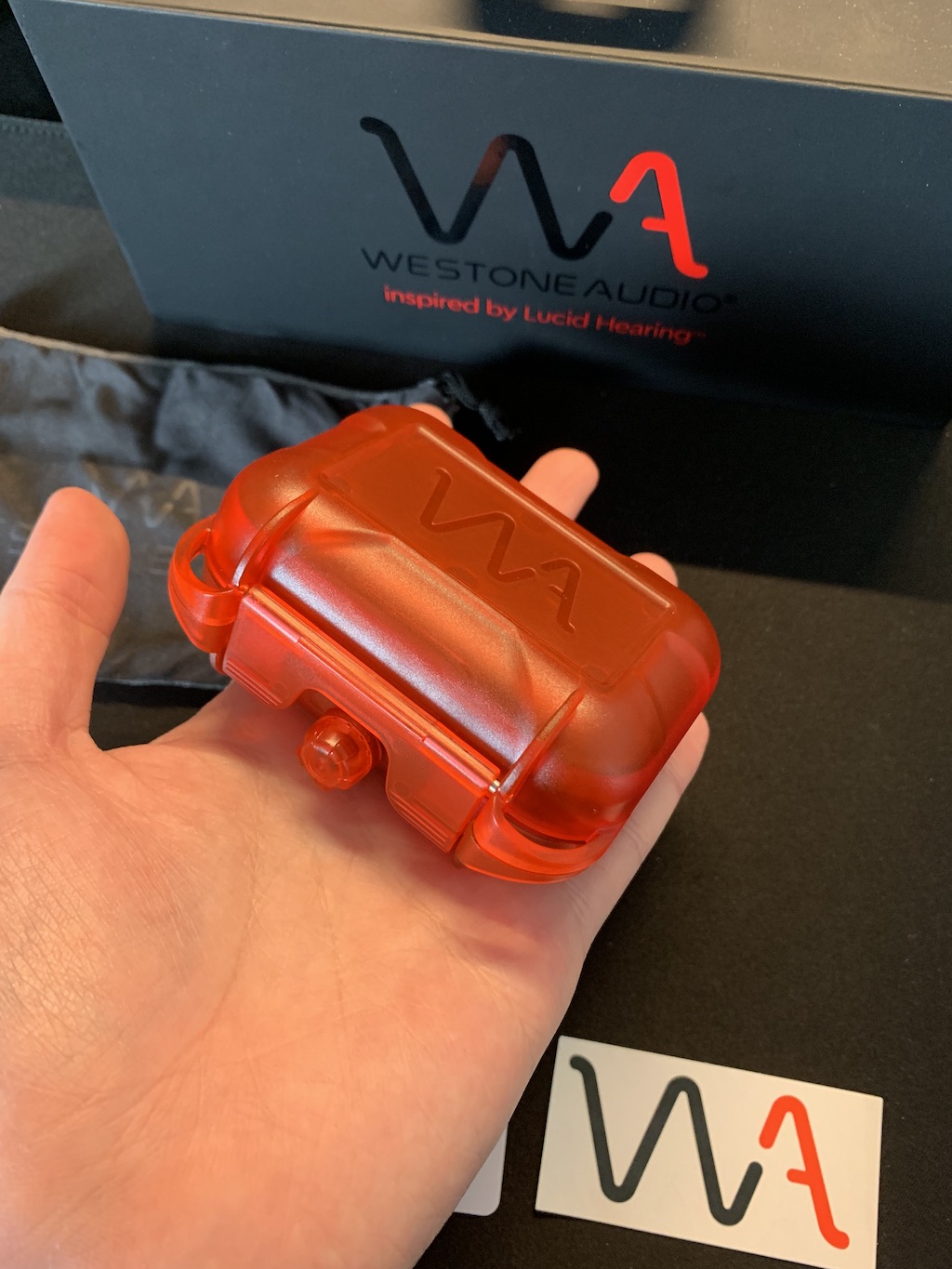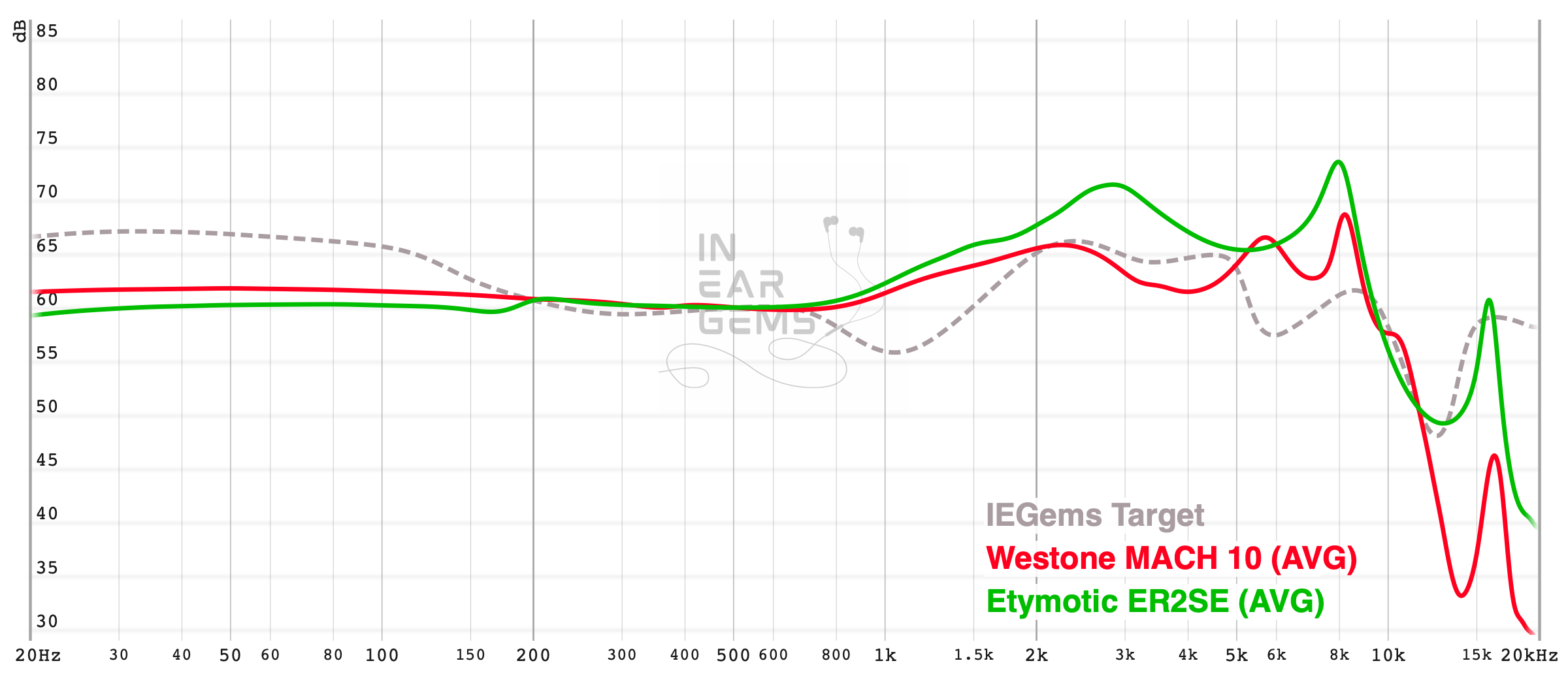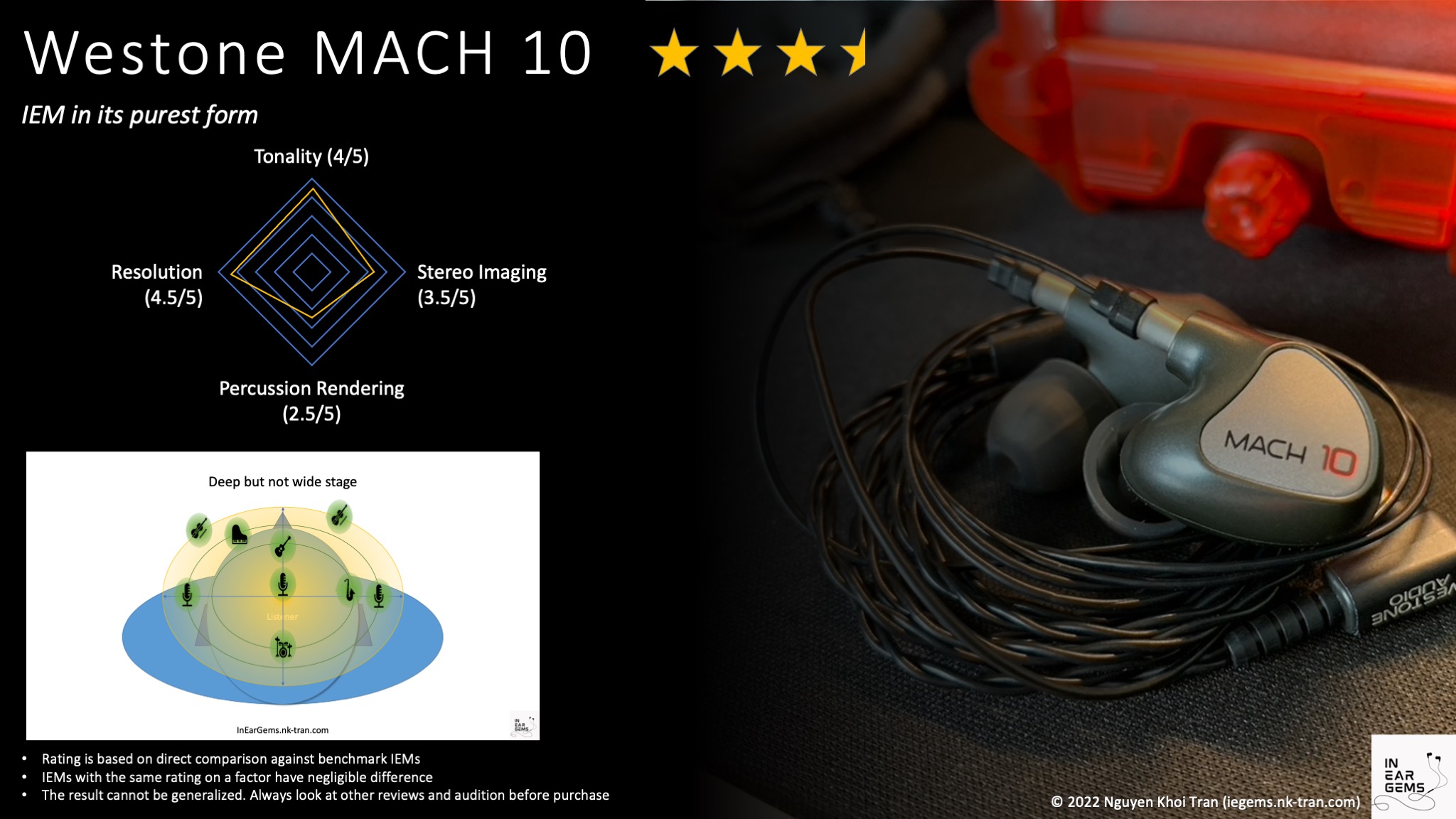Westone MACH 10 - IEM in its purest form
What is an In-ear Monitor (IEM)?
In my mind, an IEM in its purest form is a tool for musicians to hear a mix on the stage whilst protecting their hearing. Thus, a “good” IEM should be comfortable, isolating, and have a lot of clarity in the frequency band occupied by the wearer.
Westone MACH 10 hits those points harder than many IEMs that I have auditioned for a while.
Forewords
- This review is based on a loaned unit from Westone via the MACH launch tour. It has been delivered to the next reviewer in the tour. Thank you @Zachik for coordination.
- I believe that great IEMs are the ones that can achieve multiple difficult things simultaneously: (1) high resolution (meaning lines of music are crisp, clear, easy to follow and full of texture), (2) 3D soundstage with a strong sense of depth, (3) bold and natural bass with physical rumble, (4) natural timbre, (5) relaxing and comfortable tonality. IEMs achieving those criteria are rated highly in my ranking list
- I rate IEMs by A/B tests them against a few benchmark IEMs, regardless of price point. If a $1000 IEM scores the same as a $100 IEM, then either the more expensive one underperforms or the budget one is a gem. See the methodology for more detail.
- I use frequency response measurements to double check my subjective impressions.
- Rating database and measurement database can be found on my IEM review blog.
Non-sound Aspects
Specs and Driveability
- DRIVERS: Single Balanced-Armature Driver
- FREQ RESPONSE: 20Hz – 18kHz
- SENSITIVITY: 103dB @1kHz
- IMPEDANCE: 80 Ohms @1kHz
Despite having only one BA driver, MACH 10 is surprisingly hard to drive. I’m not saying that you need a desktop-class amplifier, but you will need to turn the volume higher than usual. On the plus side, because of the high impedance, MACH 10 does not hiss even when you use a noisy source like Nintendo Switch.
Most of the listening tests were done with a Hidizs AP80 Pro X. I also use Fiio KA3 and Fiio BTR5 (1st gen). The IEM sounds good with all of these sources, without any noticeable difference.
Form factor and daily uses

MACH 10 is a plastic IEM with the old-school universal IEM shape and long, thin nozzles. The stability and comfort is excellent. With the right tips, these IEMs lock into my ears and completely isolate me from the surrounding environment. The reduction of bassy noise such as engine’s rumble is nearly as good as active noise cancelling on my AirPods Pro. However, MACH 10 reduces mid- and high-frequencies better than any ANC solutions.
MACH 10 performs well in all of my daily usage scenarios. I have used this IEM for daily commute by bus, for daily walks in a windy park, and for background music in the office. I have also used it for monitoring my violin practice a couple times. No problem whatsoever.
In the box


MACH 10 comes in a unique box with a generous set of accessories:
- Mach 10 Universal fit in-ear Monitors
- Linum BaX™ T2 Cable
- 5 Pair Foam + 5 Pair Silicone
- Impact Resistance Monitor Vault
- Westone Audio Cloth Bag
I particularly like the case. It looks like a big and bulky case that has been zapped by a miniaturizing beam.
However, I’m not a big fan of the cable because it is worryingly thin and always tangles. I roadie wrap my IEMs before putting them in a carrying case to ensure that the cables unroll nicely and easily. Such nicety never happens with MACH 10, though. Its noodle-thin cable gets tangled badly almost every time I unpack the IEM. Very annoying.
How it sounds

Frequency response of MACH 10 against ER2SE and my preference target (big bass with tuning tricks for soundstage). Measurements were done with an IEC-711 compliant coupler and might only be compared with other measurements from this same coupler. The resonance peak was aligned at around 8kHz. Such a peak might be larger on the graph than in real life. Measurements above the resonance peak might not be accurate. Visit my graph database for more comparisons.
Tonality and Timbre: 4/5 - Good

Test tracks:
- Bon Jovi - Livin’ On A Prayer Drum cover ( Tarn Softwhip ): testing tonal balance. Is there too much kick drum? Is there too little kick drum? Is there enough stick impact on the snare? Are the cymbals and high hats correct sounding? How about the toms? How about vocal?
- Delibes: Lakmé - Duo des fleurs (Flower Duet), Sabine Devieilhe & Marianne Crebassa: how natural are the vocals?
- J.S. Bach: Goldberg Variations, BWV 988 - Variatio 15 Canone alla Quinta. a 1 Clav. Andante: how natural is the piano? How is the balance between various voices in the canon? Can you hear the subtle variation in dynamic (loudness) from soft to very soft throughout the variation?
- MS Gundam Build Fighters (OST): do you hear any metallic tint in the high pitched electronic instrument at the opening? Is there any harshness? Unusual tonality? This piece should be energetic but not harsh.
Thoughtful and elegant.
MACH 10 has a neutral tuning, without the usual thinness and shoutiness that tend to accompany this kind of sound signature. It means tonality and timbre of both vocal and instruments are natural and realistic. Vocals are upfront, away from the background. However, high-pitched vocals are not shrill nor straining like usual Harman-inspired IEMs. No sibilance was heard either.
Upper treble is rolled off, so you will hear fewer airy details and reverb (which might explain why MACH 10 lacks that last bit of texture and nuances to achieve a top level resolution). The good thing is that you wouldn’t hear metallic tone associated with excess upper treble energy, which is usually heard in budget single DD IEMs.
The quantity (or loudness) of bass is slightly more than the ruler-flat bass of Etymotic ER2SE. However, the added bass quantity is well balanced with the rest of the tuning, contributing only a bit of warmth to the neutral tonality rather than providing a bass boost. Therefore, if the music is not mixed with a lot of bass, MACH 10 would reflect that fact. If the mix has strong bass, MACH 10 would also respond accordingly.
In general, the tuning of MACH 10 is thoughtful, balanced, and realistic without any discomfort. It might lack some strategic dips and boosts for “special effect”, but there is a sense of lightness and honesty in the tuning that is commendable. I rate tonality 4/5 - Good
Resolution, Detail, Separation: 4.5/5 - Very Good
Resolution, detail retrieval, or “technical performance” denotes how finely and crisp an IEM or headphone can reproduce audio information. Resolution manifests itself in various aspects: (1) how clear and precise the attack of musical notes are, (2) how pinpoint musical notes are in the soundstage, (3) how detailed and nuanced the decay and reverb of musical notes are, (4) how clear can you hear background elements of a mix and (5) can you hear the whole band or orchestra. A balanced tuning might help but is not a necessity for an IEM to achieve high resolution.
Test tracks:
- Sky Mubs - Now You believe in You: testing the detail of the background elements and the treble extension / air. How clear can you follow the choral section in the background before 0:50? How crisp and texture are the claps?
- Ed Sheeran: Tiny Desk (Home) Concert: visiting hours (from 14:20) is a good test for detail retrieval. How clear and distinct can you hear the chimes at the beginning? Can you hear individual chime or just a blob of high-pitched sound? How clear can you hear the backing vocal at the far sides of the soundstage?
- Vivaldi: Violin Concerto No. 2 in G Minor, RV 315 “L’estate” - III. Presto: testing resolution in complex and dense music. How easy it is to hear individual instruments? Can you hear nuances and textures in each instruments like bow catching on the strings? Can you hear the cello on the right? Can you feel the rumble of the lower strings of cello?
In overall, MACH 10 is a bit crisper than Blessing 2 (benchmark of good IEM resolution) across the frequency spectrum. The precision and sharpness of note attacks are nearly at the same level of Andromeda (benchmark of outstanding IEM resolution). The only thing MACH 10 lacks is the details in the trailing end of the tone, making the overall stereo image a bit less textured and nuanced comparing to Andromeda.
Summer - Presto:
- MACH 10 is noticeably crisper in the bass (cello) and treble region comparing to Blessing 2.
- MACH 10 does not have “wall of sound” feeling of Blessing 2. There is more space between instruments, and the instruments are pushed back a bit.
- Note attacks on MACH 10 are as crisp as on Andromeda 2020, however the stereo image painted by Andromeda is fuller and richer with details, especially in the bass region. The difference is also noticeable in the trailing end of the notes.
Tiny Desk Performance (Visiting Hours):
- The opening chimes on MACH 10 lack the last bit of clarity of separation comparing to Andromeda.
- The surface level details are close to Andromeda enough, however. For example, the backup vocals are clear and easy to follow. Just lack a little bit at the tail end of the vocal line.
- Background vocals are sharper on MACH 10 comparing to Blessing 2. The treble clarity (chimes sound) is also sharper on MACH 10, but the difference is not very stark.
Rating: Blessing 2 (4/5 - Good) < MACH 10 (4.5/5 - Very Good) < Andromeda (5/5 - Outstanding)
Percussion Rendering: 2.5/5 - Below average
Percussion rendering reflects how well the tuning and technical performance of an IEM work together to recreate realistic sound of a drum set. Good drum hits have clear attack (controlled by frequencies from 4kHz to 6kHz), full body (midbass frequencies around 200Hz), and physical sensation (subbass frequencies around 50Hz). Good technical performance (“fast” driver) ensures that bass notes can be loud yet detailed. IEMs that cannot control bass very well tend to reduce the bass’ loudness to prevent muddiness.
Test tracks:
- Finale (William Tell Overture): How rhythmic the whole orchestra sound? Can you follow the drums clearly? How about the rhythm carried by the string and brass section? Can you hear texture and detail in the drum or just mushy thump thump sound?
- Bon Jovi - It’s My Life Drum Cover ( Tarn Softwhip ): How powerful is the kick drum? How clean are the stick impacts? Is there rumble and decay (“brrrm”)? How clear are the patterns played on the cymbals? Do the drums energise you?
- Proof of a Hero - Rise Version: This track tests only one thing: can the battle drums hype you up to pick up your longsword and chase some wyverns?
There is not much to talk about the percussion rendering of MACH 10. The stick impacts are fast and snappy as you would expect. Surprisingly, there is also a clear “thump” sound with kick drums. However, the body, the rumbling sensation, and texture of the bass is not there. You can hear enough bass to keep the rhythm, but there is not enough quantity and dynamic contrast to energise you.
Rating: ER2SE (2/5 - Lacking) < MACH 10 (2.5/5 - Below average) < Aria (3/5 - Average)
Stereo Imaging (Soundstage): 3.5/5 - Above Average
Stereo imaging or “soundstage” is a psychoacoustic illusion that different elements of a recording appear at different locations inside and around your head. Your brain creates based on the cues such as the loudness and phase differences between left and right channel. Most IEMs do not differ significantly nor can compete with headphones or loudspeakers. However, some IEMs offer a more spacious soundstage than others. Best IEMs can create multiple layers sound from closer to further away and make some instrument floating slight above your head.
Test tracks:
- We are the world(3:00 onward): This song shows some excellent stereo imaging. Can you hear soloist upfront whilst the choir is pushed further away to the background? Can you hear one choir to the left and further to the back whilst the other to the right and a bit closer to you?
- Eine kleine Nachtmusik - I. Allegro: Listen for the clear direction of each instrument in the string quartet throughout the piece. You should also be able to hear cello locating closer to than the violin 1.
- I vow to thee, my country: This song is an excellent test for layering. Can you hear the boy choir standing in front of the men choir or they are on the same flat plane?
MACH 10 is unmistakenly IEM in terms of soundstage and imaging. The center image (main vocals and instruments) almost always locates in your head. The soundstage rarely extends beyond your head, even with large orchestral recordings. As a result, listening to MACH 10 feels like listening to a tiny concert hall within your head.
Despite not having a large soundstage, MACH 10 does an excellent job in terms of instrument placement and layering. It’s easy to pin point the direction of different instruments in a mix. Thanks to the slight warmth in the lower frequencies and the excellent resolution, MACH 10 is also successful in terms of layering instruments from closer to further away, creating a sense of 3D depth to the soundstage.
Rating: Aria (3/5 - Average) < MACH 10 (3.5/5 - Above Average) < A4000 (4/5 - Good)
Conclusion

An IEM in its purest form. That’s the best way I can describe Westone MACH 10. It is comfortable, highly isolating, outstandingly resolving, and elegantely tuned. There was no attempt to pretend that its soundstage is wider or deeper than what an IEM form factor can provide.
Should you get MACH 10? At AUD $450, this IEM faces a strong competition that includes Fiio FD5, FH5s and FA7s, Final Audio E5000, Dunu Vulkan, and of course Moondrop Blessing 2. The decision to get MACH 10 depends a great deal on what you want from your IEM. If you are looking for a straightforward, well-tuned, isolating, and comfortable IEM, MACH 10 gets a recommendation with reservation from this reviewer.
